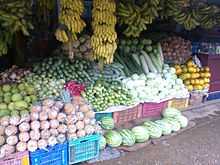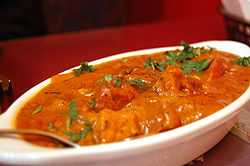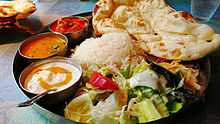Diet in Hinduism

Diet in Hinduism is traditionally governed by the rules laid out in the Dharmaśāstras, a genre of Sanskrit texts pertaining to Hindu religious and legal duty. The Dharmaśāstras has put much emphasis on Bhojana ("that which is enjoyed"). Others have attached additional Hindu Law instructions and taboos to food. Together, these address areas such as how many times food was to be defilement, whose food was to be eaten, and etiquette and ceremonies before taking food both at the time of taking it as well as after taking it.[1]
Food in the Vedas
The oldest Hindu text Rig Veda (10.87.16-19) speaks about prohibiting the flesh of the cattle and the horses:[2]
The fiend who smears himself with flesh of cattle, with flesh of horses and of human bodies,
Who steals the milch-cow's milk away, O Agni,—tear off the heads of such with fiery fury.
The cow gives milk each year, O Man-regarder let not the Yātudhāna ever taste it.
If one would glut him with the biesting, Agni, pierce with thy flame his vitals as he meets thee.
Let the fiends drink the poison of the cattle; may Aditi cast off the evildoers.
May the God Savitar give them up to ruin, and be their share of plants and herbs denied them.
Agni, from days of old thou slayest demons never shall Rākṣasas in fight o’ercome thee.
Burn up the foolish ones, the flesh-devourers let none of them escape thine heavenly arrow.
— Rig Veda (10.87.16-19)
However elsewhere the Rig Veda says:
The bridal pomp of Sūrya, which Savitar started, moved along.
In Magha days are oxen slain, in Arjuris they wed the bride.
— Rig Veda (Book 10, Hymn 85, Verse 13)[3]
Wealthy Vrsakapayi, blest with sons and consorts of thy sons,
Indra will eat thy bulls, thy dear oblation that effecteth much. Supreme is Indra over all.
Fifteen in number, then, for me a score of bullocks they prepare,
And I devour the fat thereof: they fill my belly full with food. Supreme is Indra over all.
— Rig Veda (Book 10, Hymn 86, Verse 13 to 14)[4]
Some consider this as a disapproval of the cow slaughter and meat eating in general.[5] Others put it in the context of demons and evil spirits (Yātudhāna) stealing the cattle and the milk, and mention that the beef eating was common in the Vedic times.[6][7]
Food in the Dharmaśāstras
Food is the essence of life, from which things unfold. “Everything is centered in food, the evil deeds of man resort to their food. Whoever eats the food of another partakes of that man’s sin.”[8] It is because of this that elaborate restrictions are laid out for Indian society about everything relating to food. Some obscure commands do exist in the Dharmaśāstras about food. For example, Manu says that one should face east when partaking in food and the Visnu KH. S. 68 goes on to say that a man is allowed to do so facing south, except when the diner’s mother is alive.[9] Food does, however, play a useful role in the concept of life for Hindu society. Manu II. 5 goes on to tell which direction, when eating, promotes which asset in life. Someone facing the south would eat food that would lead to fame, as one who faces west eats food to produce wealth, and so on.[10]
It is also instructed that one who is about to eat food should greet the food when it is served to him. In performing this act, he should pay honour to it, and never find fault in it.[11]
The injunctions found in the Dharmaśāstras are summarized more clearly by Patrick Olivelle in his article "From Feast to Fast: Food and the Indian Ascetic." In his work, Olivelle breaks down more clearly what the Dharmaśāstra prescribes for individual parts of Hindu society. All the topics that Kane touched on, mentioned above, are explained here in a way which relates food to both everyday life for Hindus as well as life in the cosmic realm.
The production, preparation, exchange and consumption of food have very particular processes of execution. These aspects of food are all commanded in order to protect kinship, purity, ritual, ethical values, and social stratification, each of which play a huge part in Hindu society. Food plays a central role in explaining the Hindu conception of the cosmos and creation itself. Ancient creation stories portray the creator god of the Brahmins as the creator as well as the actual food for his creatures.[12] The production of food is the immediate concern after the creation of the very first beings. Other creation myths exist, each of which, however, connect creation, food, and sacrifice. Food was held in high respects, according to the Dharmaśāstra, from the very beginning. Manu "From the sun comes rain, and from rain food, and therefrom the living creatures derive their subsistence”[13]
Kane and Olivelle both reference the command that “One should not speak ill of food. That is the rule” to further the point that food is established upon food. Food being established upon food in this text is the ancient way of describing the correlation between food and eater, that one cannot exist without the other. “The whole of creation, therefore, is a vast food chain."[14]
As well as being the source of creation, food is also seen as a danger in Hindu society. As food is the source of creation at the cosmic level, so is it the source of immorality at a social level. Food is central to sacrificial offerings to the gods. Even of the five daily sacrifices, four of them involve transaction of food. In this way, since the cosmos represents a giant food cycle, the interdependence of all beings is expressed in the transaction of food.
Although in most Dharmaśāstra texts the behavior towards food is described more for Brahmins, the elite caste, recent studies of these texts show that similar behavioral patterns existed at all levels of Hindu society. This culture has formulated many prohibitions and classifications with regard to food as a critical mechanism for the formation of social groups and the expression of leadership. Other such social classes in society that are to obey injunctions of food are the mendicant world renouncers and the sedentary forest hermits.
Food and asceticism

The world renouncer is not allowed to produce, store, or prepare food. He obtains his daily food solely by begging. Because there is a proper time for this begging, which is after the householders of the upper classes have finished their food, his meals consist of their left-overs. Distinct types of begging exist, with each different method pertaining to a different subclass of these mendicants. The lowest class eats at the house of his son or his relative, the next class does not go to the house of his relative, but rather begs his food from seven other houses. The highest, archetypal renouncer begs randomly, but obtains just a morsel from each of the houses from which he begs. As these classes of people cannot produce or store food, their relationship to this entity is one-way. The renouncer does not engage in any form of food transaction, only reception.[15]
The forest hermits, on the other hand, are not mediated in their food habits by culture. Their food is wild and uncultivated. Their diet would consist mainly of fruits, roots, leaves, and anything that grows naturally in the forest. Forbidden to them is anything that is cultivated. Gaut. III 32 and Baudh II.6.11 state that ‘He shall not step on plowed land; he shall not enter a village.’.[16] Like the renouncers, the forest hermits are further subdivided into those who cook their food and those who do not cook their food. Each of these subcategories are even further divided into five classes based upon whether they only eat grains, or only roots, and so on for those that cook. For those who do not cook their food, their five classes are based more on how they eat their food: with hands only, with mouth only and so on.
Observing ascetical food codes and habits allows scholars to make generalizations regarding food according to these patterns. For instance, Olivelle claims that four distinct areas of Hindu relationships to food exist in ascetical food practices. These would be procurement, storage, preparation, and consumption. In these areas, humans put forth much effort and energy to follow them correctly. This then, becomes a social as well as cultural endeavor for which to practice. The rules of the ascetics show that they take and eat only that which is enough for their sustenance. The creation myths at the cosmic levels show that the ideal world with provide everything humans need, so long as humans take only what is necessary to them. Taking more than one needs or what is commanded of one’s caste results in greed and the overall deterioration of the world. Food then, is a dangerous substance, as well as the source of all things in being. The relationship between a man and his food, then, is his relationship to the cosmos.
Vegetarian Hindus

As an axiomatic tenant of Hinduism, vegetarianism is purported as an ideal. From the early origins of pre-vedic doctrines, to later puranic treatises bestow the importance of vegetarianism, especially the Sattvic diet.[17] There are three main reasons for this: the principle of nonviolence (ahimsa) applied to animals,[18] the intention to offer only "pure" (vegetarian) food to a deity and then to receive it back as prasad,[19] and the conviction that non-vegetarian food is detrimental for the mind and for spiritual development. Many Hindus point to scriptural bases, such as the Mahabharata's maxim that "Nonviolence is the highest duty and the highest teaching,"[20] as advocating a vegetarian diet.
There are many Hindu groups that have continued to abide by a strict vegetarian diet in modern times. Vegetarian diet reflects the way of the traditional living ways of Indian people. One example is the movement known as ISKCON (International Society for Krishna Consciousness), whose followers “not only abstain from meat, fish, and fowl, but also avoid certain vegetables that are thought to have negative properties, such as onion, mushrooms and garlic.”[21] A second example is the Swaminarayan Movement. The followers of this Hindu group also staunchly adhere to a diet that is devoid of meat, eggs, and seafood.[22] Vegetarians generally avoid addictive substances, including tea and coffee. Their food reflects a simple Indian meal based on rice and dal, vegetable, chapattis, yogurt and milk. Also, as they are farming, they normally do not hurt worms that appear on the organic produce.[23]
Vegetarianism is propagated by the Yajurveda and it is recommended for a satvic (purifying) lifestyle.[24] Thus, another reason that dietary purity is so eminent within Hinduism is because “the idea that food reflects the general qualities of nature: purity, energy, inertia”; it follows that a healthy diet should be one that promotes purity within an individual.[21] Vallabhacharya (Mahaprbhuji) in pushti marg restricted on Onion,garlic,carot,watermelon and cabage too, before Swaminarayan siksha patri.
Non-vegetarian Hindus

Although classically perceived as a predominantly vegetarian country, recent evidence [Hindu-CNN-IBN State of the Nation Survey] has purported that many young professionals in the emerging middle classes eat meat.[25] This was often attributed to non hindus, for example the Muslims, Christians and certain elements of Buddhism. The aforementioned survey found that the majority of the population that was studied that obstained from eating meat were middle aged, female, and hindus.[26][27][28] Brahmins of East India and Kashmir and the Saraswat Brahmins of the southwest are allowed fish and some meat.[29]
Historically and currently,[30] those [[Hindus]´s] who eat meat prescribe jhatka meat.[31] This is a common method of slaughter when Bali Sacrifices are made to some Hindu deities, however, Vedic rituals such as Agnicayana involved the strangulation of sacrificial goats.[32] Many Shaivite Although the vast majority of Hindus observe a lacto-vegetarian diet[25][33] A minority of Hindus engage in jhatka methods as part of religious dietary laws, as influenced by some Shakta doctrines, which permit the consumption of meat. During Durga Puja and Kali Puja among some Shaivite Hindus in Punjab, Bengal and Kashmir, Jhatka meat is the required meat for those Shaivite Hindus who eat meat. Many Vaishnava sects prohibit the consumption of meat, and their relative demographic predominance[34] over some non-vegetarian Shaivite sects leads to a common stereotype that all Hindus are vegetarian.[35]
As Hinduism encompass a large pantheon of beliefs and doctrines, certain minority communities (for example, Rajput, Scheduled Castes, Other Backward Class, etc.) eat meat, but almost all abstain from beef and/or pork, dependent on the village culture. Although killing cows is prohibited in current mainstream Hinduism, in Nepal, some Hindus mainly Matwali ("alcohol drinking") sacrifice and consume meat from the buffalo[36] There is a disagreement on buffalo meat consumption between Indian Hindus and Nepalese Hindus on this topic as cows and buffalo are seen as related species, with Matwalis holding that buffalo consumption is an old tradition in their country, and is regularly consumed by them.[37] Buffalo meat is popular in Nepal's capital Kathmandu but is largely rejected by others, while in India, buffalo meat is entirely rejected.
See also
References
- ↑ Kane p. 757
- ↑ http://www.sacred-texts.com/hin/rigveda/rv10087.htm
- ↑ Book 10, Hymn 85, Verse 13
- ↑ Book 10, Hymn 86, Verse 13 to 14
- ↑ Editors of Hinduism Today (15 April 2007). What Is Hinduism?: Modern Adventures Into a Profound Global Faith. Himalayan Academy Publications. p. 346. ISBN 978-1-934145-27-2. Retrieved 12 February 2013.
- ↑ Raj Pruthi (1 January 2004). 11. Vedic Civilization. Discovery Publishing House. p. 2. ISBN 978-81-7141-875-6. Retrieved 12 February 2013.
- ↑ Sri M P Pandit (1 June 1990). Wisdom of the Veda. Lotus Press. p. 101. ISBN 978-0-941524-55-1. Retrieved 12 February 2013.
- ↑ Kane p. 758
- ↑ Manusmṛti 2.50
- ↑ Manusmṛti 2.52
- ↑ Kane p. 762
- ↑ Olivelle 1999 p. 19
- ↑ Manusmṛti 3.76
- ↑ Olivelle 1999 p. 21
- ↑ Olivelle 1999, p. 23–4
- ↑ Olivelle 1999 p. 25
- ↑ Sattvic diet
- ↑ Tähtinen, Unto: Ahimsa. Non-Violence in Indian Tradition, London 1976, p. 107-109.
- ↑ Mahabharata 12.257 (note that Mahabharata 12.257 is 12.265 according to another count); Bhagavad Gita 9.26; Bhagavata Purana 7.15.7.
- ↑ Mahabharata 13.116.37-41
- ↑ 21.0 21.1 Narayanan, Vasudha. “The Hindu Tradition”. In A Concise Introduction to World Religions, ed. Willard G. Oxtoby and Alan F. Segal. New York: Oxford University Press, 2007
- ↑ Williams, Raymond. An Introduction to Swaminarayan Hinduism. 1st. Cambridge: Cambridge University Press, 2001. 159
- ↑ Sanford, A Whitney."Gandhi's agrarian legacy: practicing food, justice, and sustainability in India".Journal for the Study of Religion, Nature and Culture 7 no 1 Mr 2013, p 65-87.
- ↑ Michael Keene (2002), Religion in Life and Society, Folens Limited, p. 122, ISBN 978-1-84303-295-3, retrieved May 18, 2009
- ↑ 25.0 25.1 http://www.thehindu.com/todays-paper/the-food-habits-of-a-nation/article3089973.ece
- ↑ http://www.theguardian.com/lifeandstyle/wordofmouth/2013/sep/23/best-countries-to-be-vegetarian
- ↑ Puskar-Pasewicz, Margaret (2010). Cultural Encyclopedia of Vegetarianism. ABC-CLIO. p. 39. ISBN 978-0-313-37556-9.
- ↑ Brunk, Conrad Grebel; Coward, Harold G., eds. (2009). Acceptable genes?: religious traditions and genetically modified foods. State University of New York Press. p. 168. ISBN 978-1-4384-2894-9.
- ↑ Balasubramanian, D. (21 October 2004). "Changes in the Indian menu over the ages". The Hindu. Archived from the original on 26 August 2010.
- ↑ "The Hindu : Sci Tech / Speaking Of Science : Changes in the Indian menu over the ages". Hinduonnet.com. 2004-10-21. Retrieved 2010-02-03.
- ↑ Das, Veena (13 February 2003). The Oxford India companion to sociology and social anthropology, Volume 1 1. OUP India. p. 151. ISBN 0-19-564582-0. Retrieved 13 June 2010.
- ↑ Nripendr Kumar Dutt (4 Nov 2008). Origin and Growth of Caste in India (C. B.C. 2000-300). Unknown. p. 195. ISBN 1-4437-3590-6. Retrieved 26 July 2010.
- ↑ http://www.bbc.co.uk/religion/religions/hinduism/hinduethics/animal.shtml
- ↑ Puskar-Pasewicz, Margaret, ed. (2010). Cultural Encyclopedia of Vegetarianism (Margaret Puskar-Pasewicz, editor. ed.). Santa Barbara, CA: Greenwood. p. 39. ISBN 0313375569.
- ↑ http://books.google.co.uk/books?id=QOJ5cOgJ4y8C&printsec=frontcover&dq=Intercultural+Education:+Ethnographic+and+Religious+Approaches&hl=en&sa=X&ei=iyv9T8fHHMWj8gPhiPWbBw&ved=0CDoQ6AEwAA#v=onepage&q=Intercultural%20Education%3A%20Ethnographic%20and%20Religious%20Approaches&f=false Intercultural Education: Ethnographic and Religious Approaches Page 25 By Eleanor M. Nesbitt 1845190343
- ↑ "Ritual animal slaughter begins in Nepal". CNN. 24 November 2009. Retrieved 28 January 2013.
- ↑ http://www.buffaloreview.20m.com/Leadarticle.html Rasali, D.P. (2000). "Recent trends in buffalo production in Nepal- a review.". Buffalo Newsletter. The FAO Inter-Regional Cooperative Research Network on Buffalo, Europe-Near East. (14): pp–6–10.
Bibliography
- Olivelle "From Feast to Fast: Food and the Indian Ascetic." 1999
- Kane, P.V. History of the Dharmaśāstras Vol. 2
| ||||||||||||||||||||||||||||||||||||||

